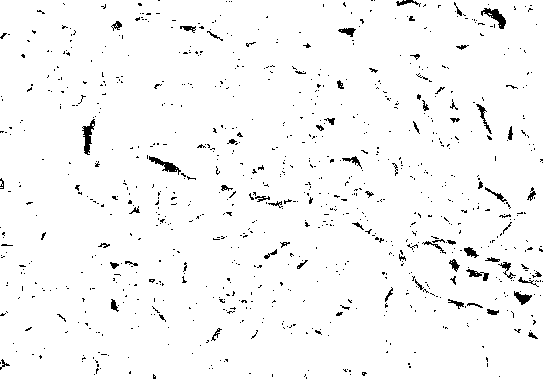Spray granulation method of non-oxide ceramic powder
A non-oxide and spray granulation technology, applied in the field of non-oxide ceramic spray granulation, can solve the problems of high cost, high bonding strength, difficult preparation, etc., and achieves good granulation formability, high output and simple process. Effect
- Summary
- Abstract
- Description
- Claims
- Application Information
AI Technical Summary
Problems solved by technology
Method used
Image
Examples
Embodiment 1
[0019] Put 850g of titanium carbide powder (D50=1.0μm), 20g of iron powder, 28.57g of aluminum powder, 48.57g of isobutylene polymer (molecular weight: 5500), 1457.14g of deionized water, and 24.29g of tetramethylammonium hydroxide into In the ball mill tank, ball mill for 8 hours to obtain a slurry with pH=9-10 and viscosity not greater than 6dpa.s. The slurry is sent to the centrifugal turntable of the spray drying granulator through a peristaltic pump, the rotation speed of the centrifugal turntable is 9600rpm, the temperature of the air inlet is 230oC, and the temperature of the air outlet is 140oC. After cooling, the pellets were collected and passed through an 80-mesh sieve to obtain pellets with a moisture content of 1.13%.
[0020] Fill the granulated material into the mold, and press it at 180MPa to obtain a sample of Φ60mm×6mm, with a density of 2.95g / cm 3 . Put it into a hot pressing mold, put it into a carbon tube furnace, and sinter at 1380oC for half an hour un...
Embodiment 2
[0023] Disperse 4900g of tungsten carbide powder (D50=3.37μm), 75.38g of carbon powder, 150.77g of aluminum phosphate, 50g of polyvinyl butyraldehyde, 50g of polyethylene glycol, 50.77g of polyacrylic acid, 2261.54g of deionized water, and disperse at high speed for 2 Hour. The slurry is sent to the centrifugal turntable of the spray drying granulator through the peristaltic pump, the rotation speed of the centrifugal turntable is 6400rpm, the temperature of the air inlet is 230oC, and the temperature of the air outlet is 130oC. After cooling, the pellets were collected and passed through an 80-mesh sieve to obtain pellets with a moisture content of 1.2%.
[0024] Fill the granulated material into the mold, and press 120MPa to form a sample of 30mm×30mm×6mm, with a density of 9.07g / cm 3 . Put it into a carbon tube furnace, heat press and sinter at 1350oC, 100MPa for 1 hour. The density of the sintered product is 15.52g / cm 3 .
[0025]
Embodiment 3
[0027] Boron carbide powder 1000g (D50=0.8μm), nickel powder 33.33g, polyvinyl alcohol 20g, polyethylene glycol 26g, polyacrylic acid 26.67g, aluminum phosphate 66.67g, deionized water 500g, high-speed stirring for 5 hours, viscosity Slurry not greater than 5dpa.s. The slurry is sent into the pressure spray drying tower through a peristaltic pump, the spray pressure is 2.0MPa, the air inlet temperature is 230oC, and the air outlet temperature is 130oC. After cooling, the granulated material was collected and passed through an 80-mesh sieve to obtain a spherical granulated material with a moisture content of 0.97%.
[0028] Fill the granulated material into the mold, and form it by isostatic pressing at 250MPa to obtain a sample of 60mm×60mm×6mm, with a density of 1.42g / cm 3 . Put it into a hot-pressing mold, put it into a carbon tube furnace, and heat-press and sinter at 1925oC and 25MPa for 1 hour. The density of the sintered product is 2.49g / cm 3 , hardness 3252HV0.3.
...
PUM
| Property | Measurement | Unit |
|---|---|---|
| Density | aaaaa | aaaaa |
| Density | aaaaa | aaaaa |
| Density | aaaaa | aaaaa |
Abstract
Description
Claims
Application Information
 Login to View More
Login to View More - R&D
- Intellectual Property
- Life Sciences
- Materials
- Tech Scout
- Unparalleled Data Quality
- Higher Quality Content
- 60% Fewer Hallucinations
Browse by: Latest US Patents, China's latest patents, Technical Efficacy Thesaurus, Application Domain, Technology Topic, Popular Technical Reports.
© 2025 PatSnap. All rights reserved.Legal|Privacy policy|Modern Slavery Act Transparency Statement|Sitemap|About US| Contact US: help@patsnap.com


